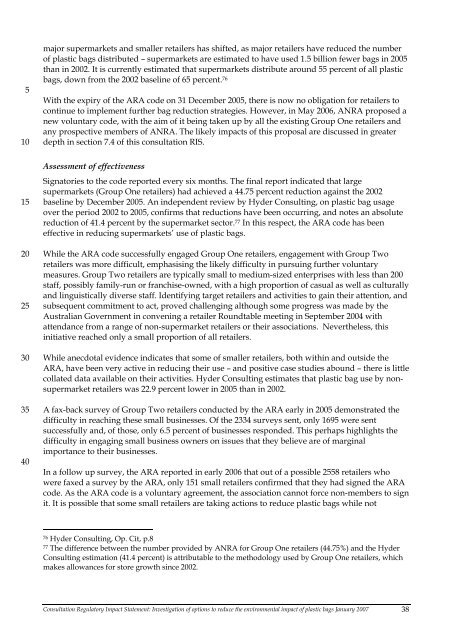Plastic Bags - COAG Standing Council on Environment and Water
Plastic Bags - COAG Standing Council on Environment and Water
Plastic Bags - COAG Standing Council on Environment and Water
You also want an ePaper? Increase the reach of your titles
YUMPU automatically turns print PDFs into web optimized ePapers that Google loves.
5<br />
10<br />
major supermarkets <strong>and</strong> smaller retailers has shifted, as major retailers have reduced the number<br />
of plastic bags distributed – supermarkets are estimated to have used 1.5 billi<strong>on</strong> fewer bags in 2005<br />
than in 2002. It is currently estimated that supermarkets distribute around 55 percent of all plastic<br />
bags, down from the 2002 baseline of 65 percent. 76<br />
With the expiry of the ARA code <strong>on</strong> 31 December 2005, there is now no obligati<strong>on</strong> for retailers to<br />
c<strong>on</strong>tinue to implement further bag reducti<strong>on</strong> strategies. However, in May 2006, ANRA proposed a<br />
new voluntary code, with the aim of it being taken up by all the existing Group One retailers <strong>and</strong><br />
any prospective members of ANRA. The likely impacts of this proposal are discussed in greater<br />
depth in secti<strong>on</strong> 7.4 of this c<strong>on</strong>sultati<strong>on</strong> RIS.<br />
15<br />
20<br />
25<br />
30<br />
35<br />
40<br />
Assessment of effectiveness<br />
Signatories to the code reported every six m<strong>on</strong>ths. The final report indicated that large<br />
supermarkets (Group One retailers) had achieved a 44.75 percent reducti<strong>on</strong> against the 2002<br />
baseline by December 2005. An independent review by Hyder C<strong>on</strong>sulting, <strong>on</strong> plastic bag usage<br />
over the period 2002 to 2005, c<strong>on</strong>firms that reducti<strong>on</strong>s have been occurring, <strong>and</strong> notes an absolute<br />
reducti<strong>on</strong> of 41.4 percent by the supermarket sector. 77 In this respect, the ARA code has been<br />
effective in reducing supermarkets’ use of plastic bags.<br />
While the ARA code successfully engaged Group One retailers, engagement with Group Two<br />
retailers was more difficult, emphasising the likely difficulty in pursuing further voluntary<br />
measures. Group Two retailers are typically small to medium-sized enterprises with less than 200<br />
staff, possibly family-run or franchise-owned, with a high proporti<strong>on</strong> of casual as well as culturally<br />
<strong>and</strong> linguistically diverse staff. Identifying target retailers <strong>and</strong> activities to gain their attenti<strong>on</strong>, <strong>and</strong><br />
subsequent commitment to act, proved challenging although some progress was made by the<br />
Australian Government in c<strong>on</strong>vening a retailer Roundtable meeting in September 2004 with<br />
attendance from a range of n<strong>on</strong>-supermarket retailers or their associati<strong>on</strong>s. Nevertheless, this<br />
initiative reached <strong>on</strong>ly a small proporti<strong>on</strong> of all retailers.<br />
While anecdotal evidence indicates that some of smaller retailers, both within <strong>and</strong> outside the<br />
ARA, have been very active in reducing their use – <strong>and</strong> positive case studies abound – there is little<br />
collated data available <strong>on</strong> their activities. Hyder C<strong>on</strong>sulting estimates that plastic bag use by n<strong>on</strong>supermarket<br />
retailers was 22.9 percent lower in 2005 than in 2002.<br />
A fax-back survey of Group Two retailers c<strong>on</strong>ducted by the ARA early in 2005 dem<strong>on</strong>strated the<br />
difficulty in reaching these small businesses. Of the 2334 surveys sent, <strong>on</strong>ly 1695 were sent<br />
successfully <strong>and</strong>, of those, <strong>on</strong>ly 6.5 percent of businesses resp<strong>on</strong>ded. This perhaps highlights the<br />
difficulty in engaging small business owners <strong>on</strong> issues that they believe are of marginal<br />
importance to their businesses.<br />
In a follow up survey, the ARA reported in early 2006 that out of a possible 2558 retailers who<br />
were faxed a survey by the ARA, <strong>on</strong>ly 151 small retailers c<strong>on</strong>firmed that they had signed the ARA<br />
code. As the ARA code is a voluntary agreement, the associati<strong>on</strong> cannot force n<strong>on</strong>-members to sign<br />
it. It is possible that some small retailers are taking acti<strong>on</strong>s to reduce plastic bags while not<br />
76 Hyder C<strong>on</strong>sulting, Op. Cit, p.8<br />
77 The difference between the number provided by ANRA for Group One retailers (44.75%) <strong>and</strong> the Hyder<br />
C<strong>on</strong>sulting estimati<strong>on</strong> (41.4 percent) is attributable to the methodology used by Group One retailers, which<br />
makes allowances for store growth since 2002.<br />
C<strong>on</strong>sultati<strong>on</strong> Regulatory Impact Statement: Investigati<strong>on</strong> of opti<strong>on</strong>s to reduce the envir<strong>on</strong>mental impact of plastic bags January 2007 38
















